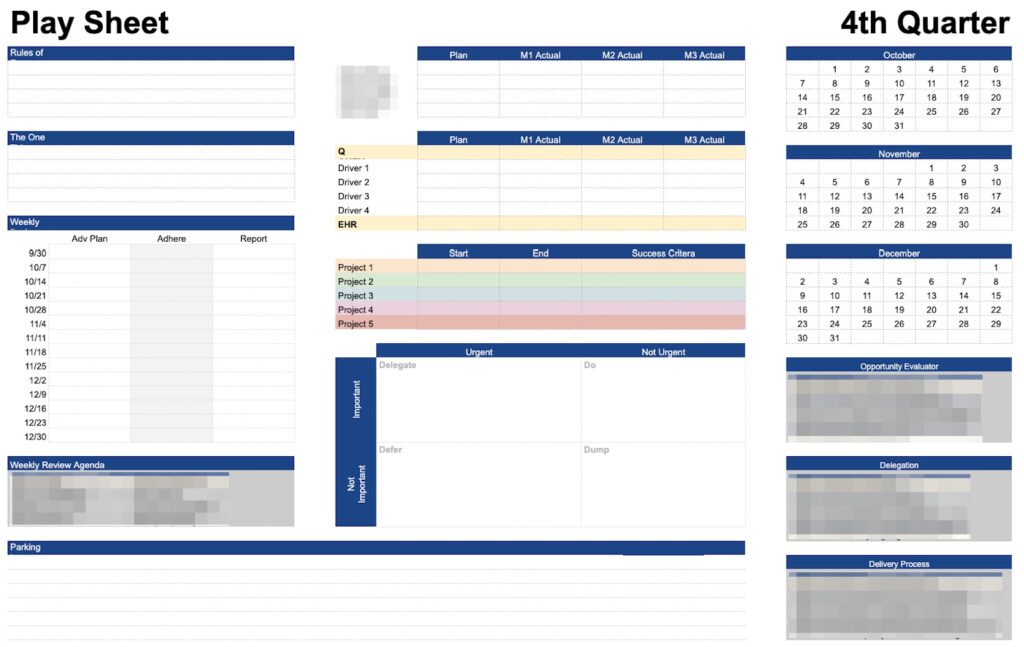There’s a reason why football coaches use playsheets instead of making it up as they go along:
So why isn’t your business using them?
Imagine this – instead of dealing with each crisis as it comes, being able to look at a single sheet of paper and know exactly what to do – no matter what comes your way.
To be sure that you’re growing the company each quarter. Complete clarity on what to do, when. Your team aligned, and rowing in the same direction.
Here’s how to make business decisions easier with playsheets:
Step 1: Set a Macro Goal
Decide the outcome you want for your business (and your role in it). If you don’t have a destination, any road will get you there. First decide on what the goals are for the company – and write it down. Now decide on the timeframe to get there.
Too often setting the goal is overlooked. Don’t skip it.
Step 2: Categorize
Break down the business into the categories that need to be systematized. Functional areas work well (Sales, Finance, HR, etc).
This is because as we build your playsheets (and scorecards), each functional department must know what’s expected of them.
Step 3: Success Criteria
For each area, decide “what must be true for the company to hit the goal in the timeframe?”
For example, to go from $4M to $6M top-line revenue in 12 months:
- Sales: what do reps need to do?
- Marketing: how many leads needed?
- HR: how many hires? etc.
It’s important at this stage to just decide WHAT needs to be accomplished, not HOW. Too often CEOs jump to how, without assessing if they have the right WHAT.
In other words, we’re just staying high level. Remember that often the best HOW will come with your team involved. Your job is to set the WHAT.
Step 4: Draw a Line
Now you know what must be true to get to your goal (say $6M top-line). Before jumping to HOW, for each area you assess where you are.
Now you draw a line from today’s resources and expected performance to the end state. In other words, “I have this team now, with this capacity, and this performance… If I extrapolate this to the desired end goal, what would that look like?”
Back to the example. For $4M -> $6M in 12 months, let’s look at the Sales function. I need to average an additional $167K/mo in new revenue. Which means X customers/mo. Which means Y reps getting Z leads. Now I know I can’t magically hire & train them all at once, so I’ll need to look to the HR function for that. And I know that I won’t add $167K/mo in extra sales in month 1. So I’ll build a ramp of hiring, getting leads, and new reps closing.
So there’s this back-and-forth with the different areas, since they need to work in concert.
Just like you need the offensive coordinator to not just focus on the QB, ignoring the rest of the offense.
Now you start to put it together:
Step 5: Build Scorecards
Now you know how each piece of the company needs to work in concert. So you run all those interdependent projects on a master play sheet.
Here’s what mine looks like (high level):

You’ll see that my Play Sheet is super high level. But each exec’s (a functional area) will have one that’s specific to how their goals contribute to the overall plan.
I run my play sheet, they run theirs.
And best of all, we know if someone isn’t following it because it’s right there in black and white. So there isn’t any “drift” as the company lets inertia keep it down.
BUT, it won’t ever go right (does it ever?)… So that’s what the back side of the Play Sheet is for. If this unexpected thing happens (dammit), how does it impact the plan? What adjustments are necessary? A static plan is doomed to fail.
On the backside is a series of “If… Then” situations. You have scenarios. So that – again – each team member knows what to do. Now this doesn’t rob them of creativity, because they’re developing those plans themselves. What it does is make sure that something going off track in one part of the company doesn’t catch the whole company by surprise.
But using a play sheet, you know exactly what to do to grow.
When I work with companies we get the entire company running on scorecards. The CEO running a Play Sheet – then handing it off to someone else. Which means you can get off the field and into the owner’s box.
Discover a weekly list of short, actionable steps to get out of operational deadlock, build a self-managing team, grow strategically, and increase company value in the Boardroom Bulletin™.


